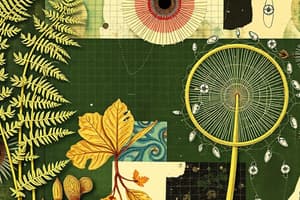Podcast
Questions and Answers
What is the primary function of the stigma in a flower?
What is the primary function of the stigma in a flower?
- To attract pollinators
- To protect the ovary
- To produce pollen grains
- To receive pollen grains (correct)
What is the process called when pollen from one flower is transferred to the stigma of another flower?
What is the process called when pollen from one flower is transferred to the stigma of another flower?
- Fertilization
- Self-pollination
- Germination
- Cross-pollination (correct)
Which of the following is NOT a function of petals in a flower?
Which of the following is NOT a function of petals in a flower?
- Producing nectar
- Attracting pollinators
- Protecting the reproductive organs (correct)
- Providing a landing platform for pollinators
Which of the following statements is TRUE about the ovary in a flower?
Which of the following statements is TRUE about the ovary in a flower?
What is the name given to the fusion of the male and female germ cells?
What is the name given to the fusion of the male and female germ cells?
What is the function of the pollen tube that grows out of the pollen grain?
What is the function of the pollen tube that grows out of the pollen grain?
What is the main difference between self-pollination and cross-pollination?
What is the main difference between self-pollination and cross-pollination?
After fertilization, what happens to the ovule?
After fertilization, what happens to the ovule?
What does a stamen primarily produce in a flowering plant?
What does a stamen primarily produce in a flowering plant?
Which part of the flower contains the ovules?
Which part of the flower contains the ovules?
What best describes a flower that contains both stamens and carpels?
What best describes a flower that contains both stamens and carpels?
What is the term for the transfer of pollen within the same flower?
What is the term for the transfer of pollen within the same flower?
Which of these is NOT a method of pollen transfer?
Which of these is NOT a method of pollen transfer?
After fertilization, the zygote develops into what structure inside the ovule?
After fertilization, the zygote develops into what structure inside the ovule?
What does the style do for the sperm cells after pollination?
What does the style do for the sperm cells after pollination?
What is the appearance of pollen grains typically described as?
What is the appearance of pollen grains typically described as?
Which part of a flower is primarily designed to attract pollinators?
Which part of a flower is primarily designed to attract pollinators?
What happens to the ovule after fertilization?
What happens to the ovule after fertilization?
Flashcards are hidden until you start studying
Study Notes
Reproductive Parts of Angiosperms
- Reproductive organs are located in the flower, comprising sepals, petals, stamens, and carpels.
- Stamens are male reproductive parts that produce yellowish pollen grains.
- Carpels are female reproductive parts, structured into three parts: ovary (contains ovules), style (middle segment), and stigma (top part, often sticky).
Flower Types
- Unisexual flowers contain either stamens (male) or carpels (female) – examples include papaya and watermelon.
- Bisexual flowers have both stamens and carpels – examples include hibiscus and mustard.
Fertilization Process
- Pollen grains from the stamen must be transferred to the stigma for fertilization to occur.
- Self-pollination occurs when pollen transfers within the same flower.
- Cross-pollination occurs when pollen transfers between different flowers, facilitated by wind, water, or animals.
Formation of Zygote and Seed
- After landing on the stigma, a tube extends from the pollen grain through the style to the ovary to reach the egg cell in the ovule.
- Successful fertilization forms a zygote, which divides to create an embryo within the ovule.
- The ovule hardens into a seed, while the ovary matures into a fruit.
Post-Fertilization Changes
- Other flower parts (petals, sepals, stamens, style, stigma) may shrink and detach after fertilization.
- Seeds contain embryos that develop into seedlings in favorable conditions, a process called germination.
Advantages of Seed Formation
- Seeds ensure the future propagation of plants, providing protection and nourishment to the developing embryo.
- They can remain dormant until conditions are right for germination, increasing survival chances for the next generation.
Reproductive Parts of Angiosperms
- Reproductive organs are located in the flower, comprising sepals, petals, stamens, and carpels.
- Stamens are male reproductive parts that produce yellowish pollen grains.
- Carpels are female reproductive parts, structured into three parts: ovary (contains ovules), style (middle segment), and stigma (top part, often sticky).
Flower Types
- Unisexual flowers contain either stamens (male) or carpels (female) – examples include papaya and watermelon.
- Bisexual flowers have both stamens and carpels – examples include hibiscus and mustard.
Fertilization Process
- Pollen grains from the stamen must be transferred to the stigma for fertilization to occur.
- Self-pollination occurs when pollen transfers within the same flower.
- Cross-pollination occurs when pollen transfers between different flowers, facilitated by wind, water, or animals.
Formation of Zygote and Seed
- After landing on the stigma, a tube extends from the pollen grain through the style to the ovary to reach the egg cell in the ovule.
- Successful fertilization forms a zygote, which divides to create an embryo within the ovule.
- The ovule hardens into a seed, while the ovary matures into a fruit.
Post-Fertilization Changes
- Other flower parts (petals, sepals, stamens, style, stigma) may shrink and detach after fertilization.
- Seeds contain embryos that develop into seedlings in favorable conditions, a process called germination.
Advantages of Seed Formation
- Seeds ensure the future propagation of plants, providing protection and nourishment to the developing embryo.
- They can remain dormant until conditions are right for germination, increasing survival chances for the next generation.
Studying That Suits You
Use AI to generate personalized quizzes and flashcards to suit your learning preferences.




